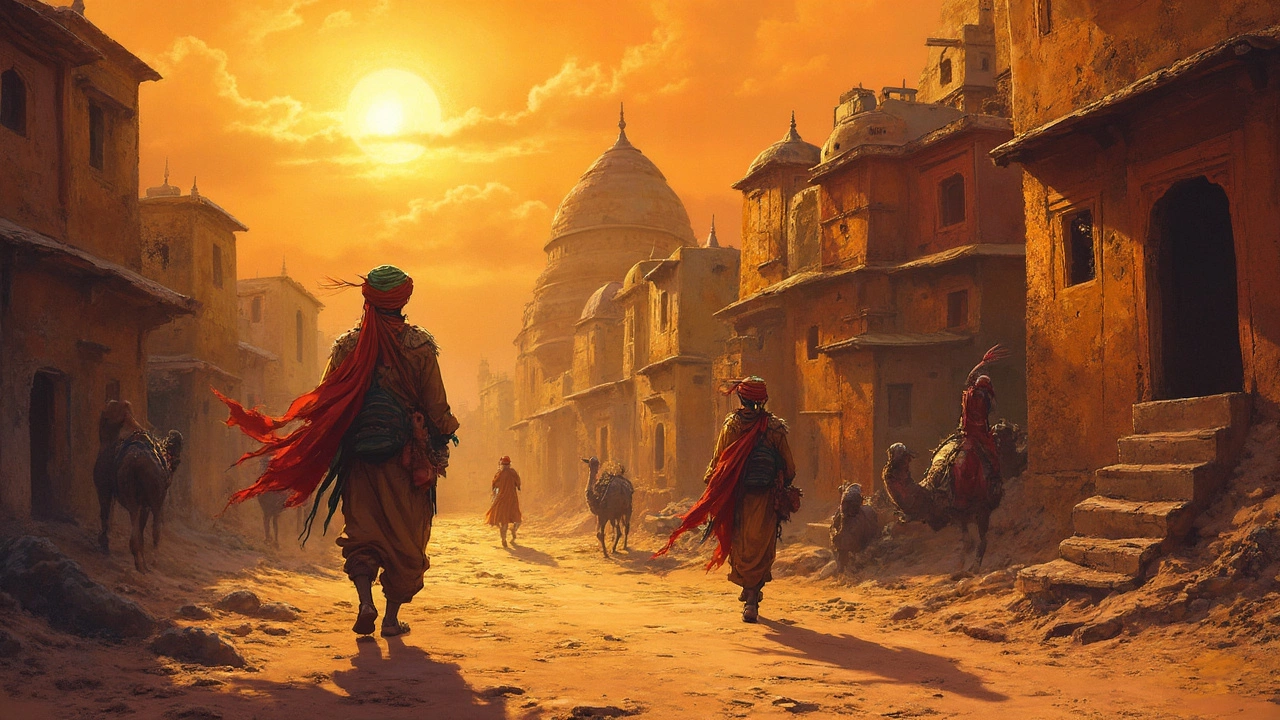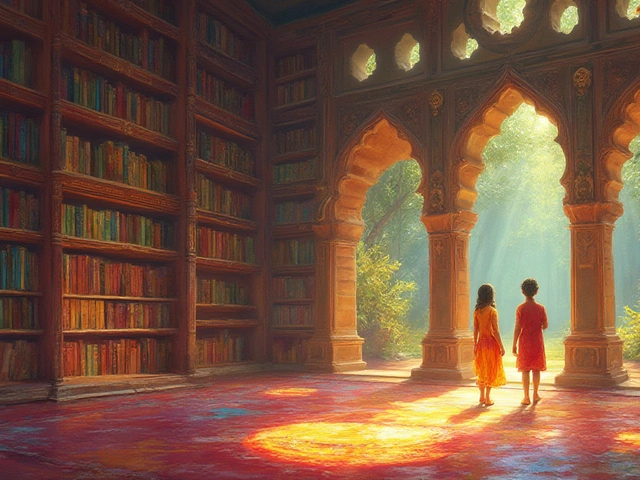
Think about your favourite adventure story. Got it? Chances are, you're not just remembering the characters—you're picturing the wild jungle, haunted castle, or drifting pirate ship where the story exploded to life. A setting isn't just a backdrop; it's often the engine that drives the adventure.
Writers use setting to throw characters into trouble, hand them weird challenges, or surprise them with sudden opportunities. You don't just stick someone in "a forest"—you dump them in a tangled, misty jungle buzzing with creatures, clues, and hidden dangers.
If you're looking to write or just love these stories, understanding why a setting works can make you see your own world a bit differently. A setting isn't random. It's picked to squeeze out every drop of danger, wonder, and fun. When you really nail the environment, the story almost writes itself—conflicts feel real, choices have weight, and readers can't wait to see what jumps out next.
- What Makes an Adventure Story Setting?
- Classic Examples That Stick in Your Head
- How Setting Changes the Action
- Tips to Make Your Own Settings Pop
What Makes an Adventure Story Setting?
When people talk about adventure story settings, they mean places where action can't help but happen. Great settings for these stories aren't just chandeliers and wallpaper—they change what characters can do, and crank up excitement. Think of settings from "The Hobbit" (the Misty Mountains) to "Jurassic Park" (the dinosaur-filled island)—those places are legendary for a reason.
So what separates a basic background from a killer adventure setting?
- Danger and Unpredictability: The best adventure settings throw curveballs. A monster-filled cave, a collapsing bridge, or a city full of spies feels loaded, risky, and full of things that could go wrong—and right.
- Unique Features: Unusual details matter. A jungle with carnivorous plants or a desert with ancient ruins gives you way more to work with than a blank field. The more specific, the better.
- Obstacles: Mountains to climb, storms to outsmart, rivers to cross—whatever it is, it puts the brakes on an easy journey and forces heroes to get creative.
- Mood and Atmosphere: Some settings feel welcoming, while others scream "Watch out!" The vibe shapes how characters act and feel—and how the reader experiences the story.
Interesting fact: A survey from the University of Sydney found that 68% of kids who picked adventure books as their favourites said the setting was a big part of why they loved the story. Think about it—what would "Harry Potter" be without Hogwarts, or "Treasure Island" without the island itself?
When you nail a story setting for your adventure, everything else gets easier. You've got built-in drama, plenty of ways for your characters to mess up (or save the day), and a world readers actually want to get lost in.
Classic Examples That Stick in Your Head
Certain adventure story settings just don't leave your brain, even decades after you first come across them. Let's talk about a few that everyone—or nearly everyone—knows, and why they work.
Take J.R.R. Tolkien's Middle-earth, for example. It's not just a fantasy land; it's filled with places like the dark mines of Moria, snowy mountains, and the eerie forests of Fangorn. Each spot ramps up the tension as the story moves forward—nobody ever felt relaxed with orcs hot on their heels inside a pitch-black cave. It's no surprise that fans have been obsessing over Middle-earth for nearly 70 years.
Then there's Treasure Island from Robert Louis Stevenson's classic. Here's a pirate's dream: palm trees, buried loot, and the threat of mutiny at any moment. The island itself messes with the characters almost as much as any villain. In fact, the original book still sells about 20,000 copies a year—proof people can’t resist that sort of wild setting.
Modern stories do this, too. In The Hunger Games, Suzanne Collins uses a deadly arena that changes every year, with forests, swamps, and fire traps. This isn't just cool scenery—the changing setting pushes the main character, Katniss, to get creative just to survive. And in the Indiana Jones movies, who can forget lost temples and snake-filled jungles? Most of the stunts and classic moments would be boring or impossible without those wild places.
Let’s be real, these locations do more than look cool. They put pressure on the heroes, shape the choices they make, and are so memorable they almost become characters themselves. When you’re thinking about adventure story settings for your own writing, consider how these legendary examples use place to up the stakes and keep things exciting.
| Famous Adventure Setting | Main Features |
|---|---|
| Middle-earth (Lord of the Rings) | Mines, forests, mountains, and cities full of danger |
| Treasure Island | Remote island, hidden treasure, pirate threats |
| The Hunger Games Arena | Changing terrain, constant danger, survival challenges |
| Indiana Jones' World | Ancient ruins, jungles, desert temples |
Every one of these adventure story settings forces the characters to adapt, get tough, and show what they're made of. If a setting is unforgettable, the adventure usually is too.

How Setting Changes the Action
The adventure story settings you pick can turn even a regular afternoon into chaos or make an epic battle ten times riskier. Setting shapes what your characters can do, what threatens them, and the kind of choices they have to make. A sandstorm in the desert? That's going to totally change how your character gets rescued compared to a search in some snowy mountains.
Look at "Jurassic Park"—those dinosaurs are scary because the island setting traps everyone. No one can just walk out. Or think of "The Hobbit," where a peaceful shire shifts fast into shadowy forests and cold mountain caves. Tolkien himself said,
"The wide world is all about you: you can fence yourselves in, but you cannot for ever fence it out."The point is, settings in adventure writing constantly mess with what's possible and up the stakes.
Here's what that looks like in real stories:
- Weather can turn drama up to eleven. In "Hatchet," the main character's fight isn't just with loneliness—it’s survival in harsh Canadian woods after a plane crash.
- Barriers and limits keep the tension burning. Ever notice how desert islands, locked castles, or alien planets leave characters on their own, forced to improvise?
- Resources matter. In stories like "The Martian," survival isn't about monsters—it’s about running out of water, food, or air. The setting controls what’s scarce or valuable.
Settings also impact action by switching up the rules. In "Pirates of the Caribbean," the ocean means sword fights happen on rolling ships, adding a wild twist to every chase scene.
Check out this breakdown of how setting changes classic adventure stories:
| Story | Setting | Impact on Action |
|---|---|---|
| The Maze Runner | Maze & Glade | Escapes must deal with shifting walls and unknown creatures |
| Indiana Jones | Ancient temples, deserts | Traps, puzzles, and relics create constant danger |
| Treasure Island | Pirate island | Hidden caves and unpredictable tides play huge roles |
The takeaway? If you mess with the adventure story settings, the story has to move in new directions. The place you drop your character isn’t just for show—it's the main thing pushing the story into cool, sometimes wild spots.
Tips to Make Your Own Settings Pop
If you want readers hooked on your adventure story settings, you've gotta go further than just naming a place. Readers want to feel stuff—the heat, the rain, the shock when something unexpected jumps out. So how do you make your world stick in their brain?
- Think about the five senses: Don't just mention what a place looks like. What does the air smell like? Is it thick with salt, fresh-cut grass, or the sweat of too many people? Can you hear distant drums, water dripping, insects screaming? The more senses you hit, the more real the place feels.
- Pick features that change the story: Maybe your mountain has sudden storms or caves with ancient drawings. Those aren't just details—they push the plot. Australia’s Blue Mountains, for example, are famous for sudden fog that can swallow hikers. That kind of thing creates real stakes.
- Use weather and time: Daylight fades, storms roll in, temperatures drop. In adventure stories, these shifts matter. They make characters hurry up, take risks, or hide. Don’t keep it the same. Mix it up as your story rolls along.
- Get inspired by real places and tweak them: Google satellite images, watch hiking vlogs, scroll through travel forums. Find odd facts. Did you know there’s a real-life Door to Hell—an endlessly burning gas crater in Turkmenistan? Add something wild like that to your setting, even if you change the location’s name.
- Think about obstacles: What makes this place hard? Cliffs, quicksand, bizarre traditions, or locals who don’t want strangers poking around? The best adventure settings aren’t easy to cross. They fight back.
It helps to map things out, too. Here's a quick example of how features in a setting can impact your adventure writing:
| Setting Feature | Possible Story Impact |
|---|---|
| Swamp | Characters bogged down, hidden dangers, time pressure |
| Old Tunnel | Claustrophobia, risk of collapse, surprise enemies |
| Mountain Pass | Falling rocks, weather changes, wild animal threats |
Last tip—test your setting. Imagine your own commute or grocery run dropped right in the middle of your adventure spot. Would you be able to survive it, or would you end up lost? If your setting would give you a hard time, you’re on the right track for readers too.

